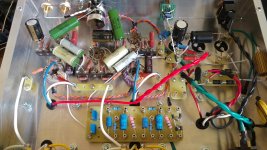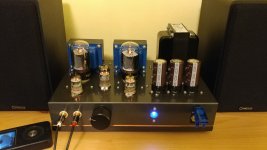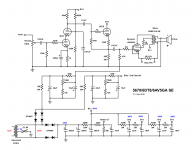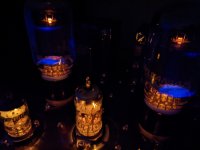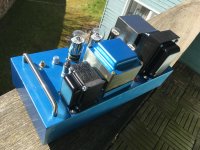This is my second go around with a hi-fi-ish amplifier. The first one was one year ago, a simple 6SN7/6V6. I got a lot of excellent feedback from the forum, and I eventually converted it to an unbypassed 6SL7 with global feedback. Unfortunately, when my kid went off to school last fall, he fast-talked me out of it with the argument that I can build another one. I finished this amp about a month ago, and had been tweaking it. Much credit to @Tubelab_com, as the output section is directly cribbed from his website. I only have a rudimentary o-scope so I can't provide any advanced measurement numbers, but it sounds really good to my ears. I think I'm finally done, and would welcome any comments and criticisms.
Attachments
Last edited:
That looks tasty! I've got some of those tubes, got some spare time... I think I'll build a copy.
Thank you for sharing!
Thank you for sharing!
Much credit to @Tubelab_com, as the output section is directly cribbed from his website.
His 6AV5 thread is the reason I bought a bunch. Maybe it's time to do something with them.
Congrats, that's a great looking build.
jeff
His 6AV5 thread is the reason I bought a bunch
I still have 10 or 20 in a box somewhere. Much of my current tinkering has been with much bigger tubes, or some much smaller tubes.....Yes, I can get 30 watts at 3% THD from a pair of 50C5 tubes from an old radio. They are running on 340 volts and there is nothing glowing. I have even played guitar through it with no fireworks!
I got tired of waiting for a pair of OTs from Edcor, so it's time to rip into an existing amp. I made a pair of socket adaptors to go from 6JC5 to 6AV5. I had to up the dropping resistor in the bias circuit to 100k to be able to bias the 6JC5 (56 mA). I could have just jumped the 10k resistor on the trimmer, but that would have pushed the power dissipation across the trimmer too close to the limit. I put in a parallel 100k resistor on a switch so I can go back to 6AV5 without too much hassle. (I tried a 75k resistor, but I could not get either tube to their proper bias.)
The 6JC5 is really surprising. The bass is noticeably fuller than the 6AV5, otherwise just as dynamic. It also has a nice blue glow.

The 6JC5 is really surprising. The bass is noticeably fuller than the 6AV5, otherwise just as dynamic. It also has a nice blue glow.
Attachments
6FW5 will fit the same socket as the 6AV5. No wiring changes.
175 mA DC rating versus 110 mA rating for the 6AV5. And 18 Watt rating versus 11 Watt.
The 6FW5 will give the lowest output Z in triode at the plate also:
6FW5 Ri 560 Ohm
6AV5 Ri 820 Ohm
6JC5 Ri 1700 Ohm
6JC5 will only do 75 mA DC.
175 mA DC rating versus 110 mA rating for the 6AV5. And 18 Watt rating versus 11 Watt.
The 6FW5 will give the lowest output Z in triode at the plate also:
6FW5 Ri 560 Ohm
6AV5 Ri 820 Ohm
6JC5 Ri 1700 Ohm
6JC5 will only do 75 mA DC.
Last edited:
and dont forget the 12AV5GA either. I'm glad I picked up a total of 24 when I could. I am using them in a Lynn Olson Amity Clone..... I know - they are not DHT's but the amp is fantastic with these tubes.
The 6AV5, when triode wired, closely resembles the 6B4G DHT. Sylvania did that trioding (internally) to fulfill a military contract. Overall, the triode wired sweep tube might not be as "sweet" as a genuine DHT, but hum will not bite your bottom.
6FW5 will fit the same socket as the 6AV5. No wiring changes.
175 mA DC rating versus 110 mA rating for the 6AV5. And 18 Watt rating versus 11 Watt.
The 6FW5 will give the lowest output Z in triode at the plate also:
6FW5 Ri 560 Ohm
6AV5 Ri 820 Ohm
6JC5 Ri 1700 Ohm
6JC5 will only do 75 mA DC.
I have a nice stash of 6FW5s too. That's a beefy tube. The Sylvania 6AV5GA, at least physically, look exactly like the GE 6FW5. I ran them very conservatively. 300 V at the plate, 60 mA.
The 6AV5, when triode wired, closely resembles the 6B4G DHT. Sylvania did that trioding (internally) to fulfill a military contract. Overall, the triode wired sweep tube might not be as "sweet" as a genuine DHT, but hum will not bite your bottom.
I remember encountering these 6AV5s with the screen hardwired to plate. I guess that means its safe to not use a 100 ohm screen grid suppression resistor if Sylvania just shorted the pins internally.... Still, my experience with triode wired beam tubes is that the screen grid resistor prevents oscillation.
DHTs in PP wont be sweet at all either - because H2 will get cancelled...
DHTs in PP wont be sweet at all either - because H2 will get cancelled...
The PP 6B4G amp I heard years ago was rather sweet.
jeff
It's true that even order harmonic distortion products produced in a PP O/P stage get cancelled in the O/P "iron". However, that which is present in the I/P waveform is not cancelled. Use a SE 12AT7 section in the small signal circuitry and see what the net distortion spectrum is, at a "dummy" load.
Eli,
Then do like so many do, throw lots of Global Negative Feedback at the amplifier, and squash the 2nd harmonic distortion of the 12AT7.
It is all a system.
Each part and each circuit does what it does, until global negative feedback comes along and changes the sum total.
Sometimes Positive Synergy.
Sometimes Negative Synergy.
And no, I am not opposed to negative feedback; when it fits the overall design, and is implemented properly.
But most of my amplifiers do not use global negative feedback; I sometimes use negative feedback that is very local.
Then do like so many do, throw lots of Global Negative Feedback at the amplifier, and squash the 2nd harmonic distortion of the 12AT7.
It is all a system.
Each part and each circuit does what it does, until global negative feedback comes along and changes the sum total.
Sometimes Positive Synergy.
Sometimes Negative Synergy.
And no, I am not opposed to negative feedback; when it fits the overall design, and is implemented properly.
But most of my amplifiers do not use global negative feedback; I sometimes use negative feedback that is very local.
Last edited:
Nelson Pass observed that not only the amount of 2nd Harmonic, but its phase relative to the fundamental makes a perceptible difference. Quoted from his art_h2_v1.pdf article :... see what the net distortion spectrum is, at a "dummy" load.
Nelson Pass said:So why is the phase important? Well, it's a subtle thing. I don't suppose everyone can hear it, and fewer particularly care, but from listening tests we learn that there is a tendency to interpret negative phase 2nd as giving a deeper soundstage and improved localization than otherwise. Positive phase seems to put the instruments and vocals closer and a little more in-your-face with enhanced detail.
Hmmm, seems like inverting the polarity of 2nd harmonic gives the same waveforms. Maybe a 90 degree shift?
Maybe the non-linearity of the speaker is what makes the difference. Plus pressure sounding different from neg. pressure.
Maybe the non-linearity of the speaker is what makes the difference. Plus pressure sounding different from neg. pressure.
Last edited:
There is also addition or cancellation of driver generated 2nd harmonic depending on phase. And using a single driver speaker should be the easiest way to observe the stated effect.
Last edited:
Hello, I built à PSE 2A3 in the past.
As true 2a3 began tooo extensive , I rewirered for true nos 6b4g.
As 6b4g ect... went to 6av5 and was Very happy with the sound.
Was cheap to built.
As true 2a3 began tooo extensive , I rewirered for true nos 6b4g.
As 6b4g ect... went to 6av5 and was Very happy with the sound.
Was cheap to built.
Attachments
Last edited:
- Home
- Amplifiers
- Tubes / Valves
- A Decade Too Late, and a Dollar Short--6AV5GA
